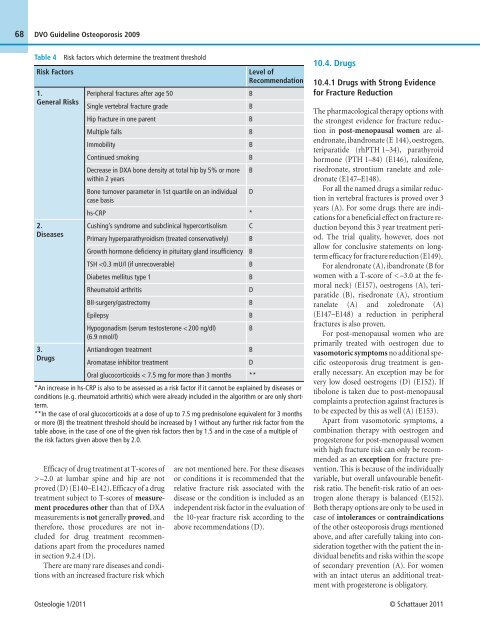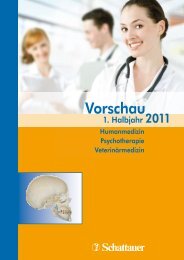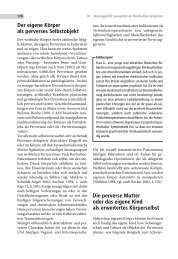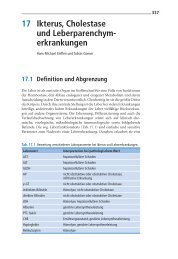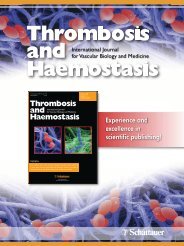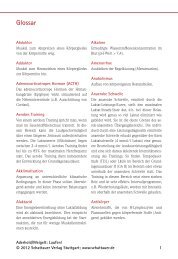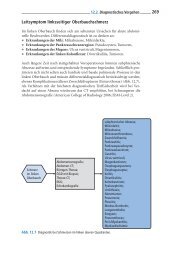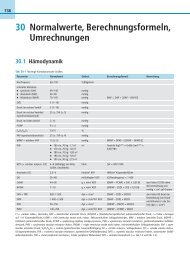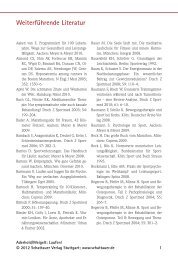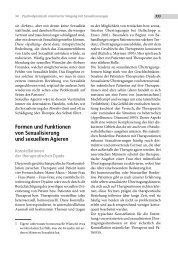DVO Guideline 2009 for Prevention, Diagnosis and Therapy of ...
DVO Guideline 2009 for Prevention, Diagnosis and Therapy of ...
DVO Guideline 2009 for Prevention, Diagnosis and Therapy of ...
Create successful ePaper yourself
Turn your PDF publications into a flip-book with our unique Google optimized e-Paper software.
68 <strong>DVO</strong> <strong>Guideline</strong> Osteoporosis <strong>2009</strong><br />
Table 4 Risk factors which determine the treatment threshold<br />
Risk Factors Level <strong>of</strong><br />
Recommendation<br />
1.<br />
General Risks<br />
2.<br />
Diseases<br />
3.<br />
Drugs<br />
Peripheral fractures after age 50 B<br />
Single vertebral fracture grade B<br />
Hip fracture in one parent B<br />
Multiple falls B<br />
Immobility B<br />
Continued smoking B<br />
Decrease in DXA bone density at total hip by 5% or more<br />
within 2 years<br />
B<br />
Bone turnover parameter in 1st quartile on an individual<br />
case basis<br />
hs-CRP *<br />
Cushing’s syndrome <strong>and</strong> subclinical hypercortisolism C<br />
Primary hyperparathyroidism (treated conservatively) B<br />
Growth hormone deficiency in pituitary gl<strong>and</strong> insufficiency B<br />
TSH –2.0 at lumbar spine <strong>and</strong> hip are not<br />
proved (D) (E140–E142). Efficacy <strong>of</strong> a drug<br />
treatment subject to T-scores <strong>of</strong> measurement<br />
procedures other than that <strong>of</strong> DXA<br />
measurements is not generally proved, <strong>and</strong><br />
there<strong>for</strong>e, those procedures are not included<br />
<strong>for</strong> drug treatment recommendations<br />
apart from the procedures named<br />
in section 9.2.4 (D).<br />
There are many rare diseases <strong>and</strong> conditions<br />
with an increased fracture risk which<br />
are not mentioned here. For these diseases<br />
or conditions it is recommended that the<br />
relative fracture risk associated with the<br />
disease or the condition is included as an<br />
independent risk factor in the evaluation <strong>of</strong><br />
the 10-year fracture risk according to the<br />
above recommendations (D).<br />
10.4. Drugs<br />
10.4.1 Drugs with Strong Evidence<br />
<strong>for</strong> Fracture Reduction<br />
The pharmacological therapy options with<br />
the strongest evidence <strong>for</strong> fracture reduction<br />
in post-menopausal women are alendronate,<br />
ib<strong>and</strong>ronate (E 144), oestrogen,<br />
teriparatide (rhPTH 1–34), parathyroid<br />
hormone (PTH 1–84) (E146), raloxifene,<br />
risedronate, strontium ranelate <strong>and</strong> zoledronate<br />
(E147–E148).<br />
For all the named drugs a similar reduction<br />
in vertebral fractures is proved over 3<br />
years (A). For some drugs there are indications<br />
<strong>for</strong> a beneficial effect on fracture reduction<br />
beyond this 3 year treatment period.<br />
The trial quality, however, does not<br />
allow <strong>for</strong> conclusive statements on longterm<br />
efficacy <strong>for</strong> fracture reduction (E149).<br />
For alendronate (A), ib<strong>and</strong>ronate (B <strong>for</strong><br />
women with a T-score <strong>of</strong> < –3.0 at the femoral<br />
neck) (E157), oestrogens (A), teriparatide<br />
(B), risedronate (A), strontium<br />
ranelate (A) <strong>and</strong> zoledronate (A)<br />
(E147–E148) a reduction in peripheral<br />
fractures is also proven.<br />
For post-menopausal women who are<br />
primarily treated with oestrogen due to<br />
vasomotoric symptoms no additional specific<br />
osteoporosis drug treatment is generally<br />
necessary. An exception may be <strong>for</strong><br />
very low dosed oestrogens (D) (E152). If<br />
tibolone is taken due to post-menopausal<br />
complaints a protection against fractures is<br />
to be expected by this as well (A) (E153).<br />
Apart from vasomotoric symptoms, a<br />
combination therapy with oestrogen <strong>and</strong><br />
progesterone <strong>for</strong> post-menopausal women<br />
with high fracture risk can only be recommended<br />
as an exception <strong>for</strong> fracture prevention.<br />
This is because <strong>of</strong> the individually<br />
variable, but overall unfavourable benefitrisk<br />
ratio. The benefit-risk ratio <strong>of</strong> an oestrogen<br />
alone therapy is balanced (E152).<br />
Both therapy options are only to be used in<br />
case <strong>of</strong> intolerances or contraindications<br />
<strong>of</strong> the other osteoporosis drugs mentioned<br />
above, <strong>and</strong> after carefully taking into consideration<br />
together with the patient the individual<br />
benefits <strong>and</strong> risks within the scope<br />
<strong>of</strong> secondary prevention (A). For women<br />
with an intact uterus an additional treatment<br />
with progesterone is obligatory.<br />
Osteologie 1/2011 © Schattauer 2011<br />
D<br />
B<br />
B<br />
D<br />
B<br />
B<br />
B<br />
B<br />
D<br />
**


